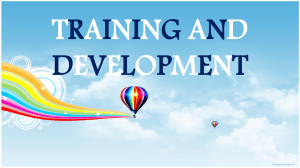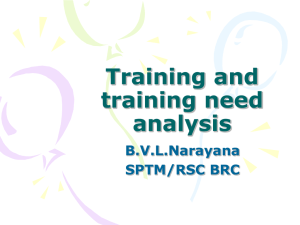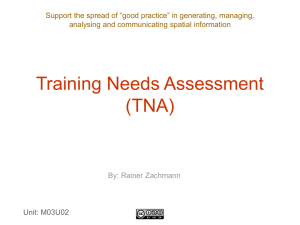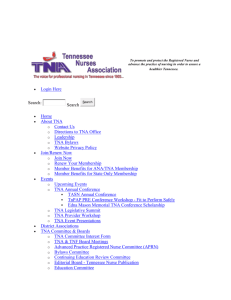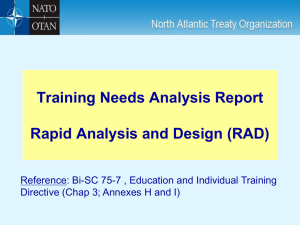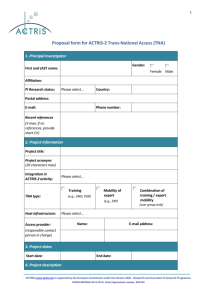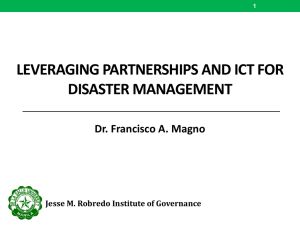cdetp annexes - WordPress.com
advertisement
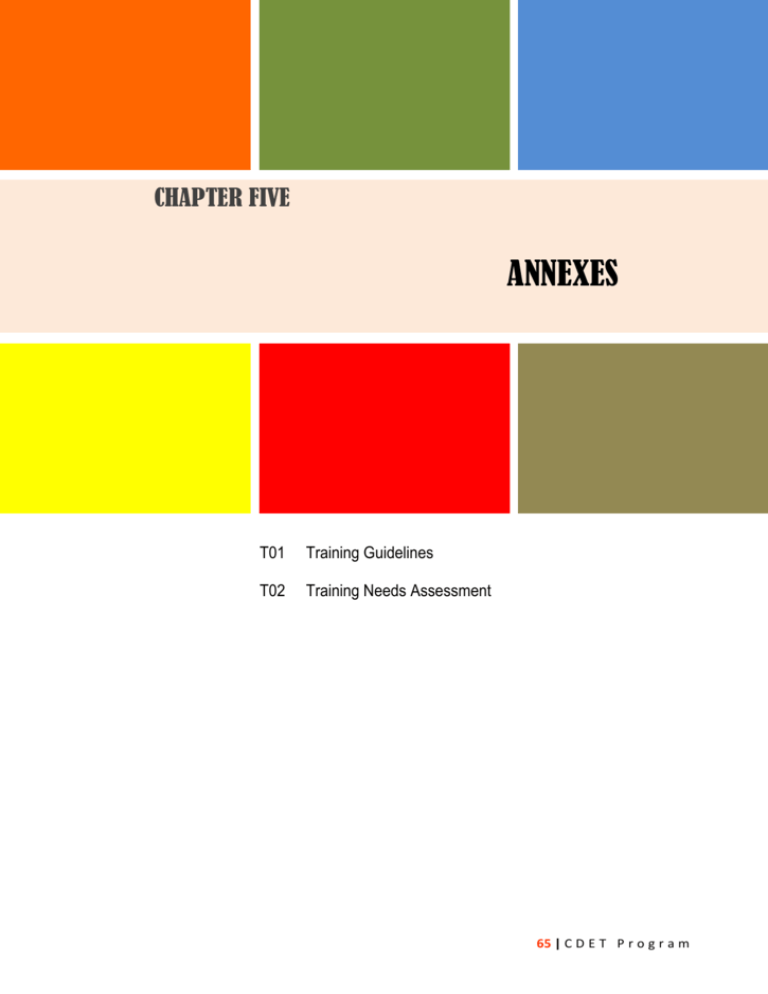
CHAPTER FIVE ANNEXES T01 Training Guidelines T02 Training Needs Assessment 65 | C D E T P r o g r a m 66 | C D E T P r o g r a m 67 | C D E T P r o g r a m 68 | C D E T P r o g r a m 69 | C D E T P r o g r a m 70 | C D E T P r o g r a m 71 | C D E T P r o g r a m 72 | C D E T P r o g r a m 73 | C D E T P r o g r a m 74 | C D E T P r o g r a m 75 | C D E T P r o g r a m 76 | C D E T P r o g r a m 77 | C D E T P r o g r a m 78 | C D E T P r o g r a m 79 | C D E T P r o g r a m 80 | C D E T P r o g r a m 81 | C D E T P r o g r a m TRAINING NEEDS ASSESSMENT Training Needs Assessment (TNA) is a process of gathering data to determine what training needs exist so training can be developed to help the organization accomplished its objectives. Conducting needs assessment is essential to success of a training program. Organizations who failed to conduct needs assessment run the risk of overdoing training, doing too little training of missing the point completely. There are four reasons why the conduct of TNA is important before training programs are developed. First, TNA can be a tool to identify of problem areas in the organization. HR and management must know what the problems are so that the appropriate training (if training is the solution) is required to answer these organizational problems. Second, TNA can be used to solicit management support. Support of management for training programs can be obtained if HR can show that training can produce a positive impact in the performance on the job and making a contribution to the bottom line. Third, TNA assists to develop data for evaluation. Conducting needs assessment can will enable HR and management to measure the effectiveness of a program. Fourth, TNA can be used to determine the cost and benefits of training. Training is usually looked upon as an expense and not as an investment of an organization. This usually happens when HR failed to conduct costbenefit analysis between the cost of not training conducted versus the cost of training and its effect(s) to the organization. Therefore, it is significant to consider these four reasons in order to develop an effective training program. Purposes and Objectives of TNA for OCD The Training Needs Assessment (TNA) aims to establish the connection between OCD’s Vision/Mission and its training activities, and set the annual training directions by determining the appropriateness, context and extent of both organizational and employees’ capability building needs. Performance requirements and the knowledge, skills, and abilities needed by OCD’s workforce are identified and aligned for the attainment of its strategic goals, based on RA 10121, through provision of the right training programs. Likewise, TNA will identify the “gap” between performance required and current performance; explores the cause and reasons for the gap; and determine methods for closing or eliminating the gap. Moreover, it determines non-training needs that will contribute to performance improvement in the workplace. Therefore, conducting a TNA is useful to identify organizational goals and its effectiveness in achieving these goals; and identification of gaps between employee skills and the required skills for effective job performance. However, other problems may not be solved by training. HR and management should be aware that training is not the panacea for organizational problems. The purpose of training is to support the attainment of organizational goals by developing the necessary competencies of its employees. It should not be used as a tool to reward excellent performance or as motivation to correct poor performance. If policies, practices and procedures need to be corrected or adjusted, this is a concern for top management, not a training concern. 82 | C D E T P r o g r a m Types of Analysis 3. Individual Analysis Needs analysis are classified into three (3) levels: 1. Individual analysis targets individual employees and how they perform in their jobs. Information or data from employee’s performance review can be used in determining training program needs is the most common method. If there is deficiency in the employee’s performance review, training can be designed to help the employee meet the performance standard. Organizational Analysis Organizational analysis examines where training is needed in the organization and under what conditions the training will be conducted. It identifies what knowledge, skills and abilities (KSAs) that the employees will need for the future, as the organization and their jobs evolves or changes. As for the OCD what are the KSAs needed by OCD employees to cope with the requirements of its new mandate under RA 10121. Analysis of HR data can indicate areas where training could improve performance. After thorough analysis, training objectives can be determined and the appropriate training developed. Survey, interview or tests can also be used to determine employee training needs. They can indicate problems they have or provide recommendation to solve problems. Interview can be conducted on an individual or in a group basis. Guidelines in Conducting Training Needs Assessment 1. 2. Task Analysis Task analysis begins with job requirements and compares employees’ knowledge and skills to determine training needs. Analyzing job descriptions and specifications provide necessary information on expected performance and the skills needed by employees to accomplish their work. A good task analysis identifies tasks that have to be performed; conditions which tasks are to be performed; how often and when tasks are performed; quantity and quality of performance required; skills and knowledge required to perform tasks; and where and how these skills can be acquired. The TNA shall be conducted to ensure that training programs (internal and external) and other capacity enhancement activities or interventions shall be connected to OCD’s Vision/Mission; aligned with the Organizational Strategic Plans and Programs; and addresses organizational and employees’ needs. 2. The TNA process shall likewise consider non-training interventions that may provide a positive impact to performance in the workplace. 3. The conduct of TNA shall be in collaboration with OCD Central Office Division Chiefs and Regional Directors. 4. The TNA shall take into consideration the OCD’s thirteen (13) Core Competencies to 83 | C D E T P r o g r a m determine the institutional performance and competency needs in achieving the Office’s thrust and direction. 5. The TNA shall be conducted organizationwide by the Human Resource Management and Development (HRMD) Division, once every three (3) years to be reviewed yearly together with the Office’s Planning Process and as needed. 6. The TNA shall be conducted during office hours and participated in by target respondents – Division Chiefs and employees of OCD Central and Regional Offices. 7. The TNA report shall be approved by the Civil Defense Administrator (CDA) before dissemination of copies to the different Divisions and Regional Offices. 8. The TNA report shall be the basis of the HRMD Division and Education and Training Division in drafting the training plan for its central and regional employees. Requisites 1. The TNA respondents shall cover fifty percent (50%) plus one (1) of the total number of employees (permanent and contractual) of OCD for reliability of data. 2. References Previous TNA reports, if any OCD Vision/Mission Annual Plans and Program OCD Thirteen (13) Core Competencies for Employees 3. TNA Instruments Survey Questionnaires TNA Summary Report Training (Survey) 1. Needs Assessment Tool The TNA tool is a self-assessment instrument that allows the respondent to actually measure the level of competencies they possess in fulfilling their functions based on the mandate of their Office/Division/Section. 2. Employees will conduct their own assessment based on three (3) categories namely: (1) Importance Level, (2) Relevance to Actual Position/Function, and (3) Knowledge and competency level. 3. Importance Level – DRRM training programs that an employee needs to undertake in order to effectively perform his duties and functions as a Civil Defense employee. 4. Relevance to Actual Position/Function – DRRM training interventions that is significant to employee’s current position/function. 5. Knowledge/Competency Level – level of knowledge, skills and abilities of an employee on different DRRM tools (Philippine Disaster Risk Reduction and Management System (PDRRMS), Map Appreciation, Early Warning System, Incident Command System (ICS), etc.). 6. Assessment rating for the three (3) categories are scaled from 1 to 4, which are particularly described as follows: Category Rate Description Importance Level 1 Not important 2 Not so important 3 Somehow important 84 | C D E T P r o g r a m 4 Relevance to Actual Position/Function 1 2 3 Knowledge/Comp etency Level (Actual) 4 1 2 3 4 Very important Not relevant Not so relevant Somehow relevant Very relevant Fair Knowledge/ Competency Level Good Knowledge/C ompetency Level considered as priority as well as the employees who will participate in the said programs. The determination of the priority training programs and participants will be based on the average of the accumulated ratings on the categories. 5. The results will be presented to the OCD Administrator for approval and implementation of the training. Satisfactory Level Very Satisfactory Level Procedures and Processing of TNA Tool 1. A minimum of 51% of the total workforce (permanent and contractuals) will be required to take the survey (TNA Tool) for a more reliable data. 2. Respondents will be asked to fill out all the required information in the TNA tool, which includes its actual responsibilities, for a better assessment/evaluation by the evaluators (HRMD OPR) 3. Categories for each training program will be rated in a scale of 1 (lowest) to 4 (highest) by shading the corresponding column. 4. Survey forms will be collected and processed. The results will identify what DRRM training programs will be 85 | C D E T P r o g r a m DRRM TRAINING NEEDS ASSESSMENT Name: Salary Grade: Position: Designation: Place of Assignment: Actual Responsibilities: Score: DRRM Training Needs Assessment Importance Level Relevance to Actual Position/Function Knowledge/Competency Level 1 Not Important 1 Not Relevant 1 Fair Knowledge/Competecy 2 Not so Important 2 Not so Relevant 2 Good Knowledge/Competency 3 Somehow Important 3 Somehow Relevant 3 Satisfactory 4 Very Important 4 Very Relevant 4 Very Satisfactory Importance Level 1 2 3 4 Relevance to Actual Position/Function 1 2 3 4 DRRM TRAININGS Philippine Disaster Risk Reduction and Management System (PDRRMS): provides a background of the country’s disaster risk profile; Republic Act 10121; NDRRM Framework; Sectoral Approach; and DRRM Four (4) Thematic Areasrequirement for management and operations no longer exist. Map Appreciation and Risk/Hazard Mapping: provides knowledge on how to interpret scientific-based and locally driven maps and utilize these maps for DRRM Activities such as Contingency Planning and Risk Assessments Early Warning System: provides an understanding of early warning system: from its development, dissemination to implementation. Incident Command System: interdisciplinary and organizationally flexible response system designed to be used or applied from the time an incident occurs until the requirement for management and operations no longer exist. Knowledge/Competency Level (Actual) 1 2 3 4 Rapid Damage Assessment and Needs Analysis (RDANA): provides a quick “snapshot” of the disaster situation. It determines the type and extent of damages brought about by a disaster, including its secondary threats, the critical needs of the effected population, and the local response capabilities. Post Disaster Needs Assessment: multi-sectoral and multidisciplinary structured approach for assessing disaster impacts and prioritizing recovery and reconstruction needs. Contingency Planning: a management process that analyzes specific potential events or emerging situations that might threaten society or the environment and establishes arrangements in advance to enable timely, effective and appropriate responses to such events and situations. Community-Based Disaster Risk Reduction and Management: process of disaster risk reduction and management in which at-risk communities are actively engaged in the identification, analysis, treatment, monitoring and evaluation of disaster risks in order to reduce their vulnerabilities and enhance their capacities and where the people are at the heart of decision-making and implementation of disaster risk reduction and management activities. Other DRRM-related training needs not included in this survey: Note: Importance Level: DRRM training programs that employees need to undertake in order to perform their duties and functions as Civil Defense employees. 66 | C D E T P r o g r a m


